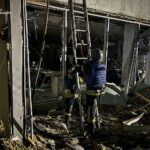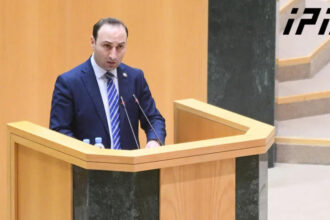Russian forces attempted to surround Vadar by crossing multiple rivers, gullies and lowlands. Ukrainians held high ground on opposing mountain ridges.
Day 959
The biggest developments on 9 October came from the direction of Vuhledar. Here, Russians attempted desperately to close their encirclement in Vuhledar and capture the entire Ukrainian force but were forced to engage intense urban combat and go through town instead of going around it.
After their bitter defeat, the Ukrainians set up a second line of defense and left the Russians in the mud that will soon arrive.
Russians were on the verge of encircling the town, trapping Ukrainian forces, after crossing the river from the West and advancing from Bodani. Russians also targeted the only Ukrainian supply routes into the city, causing a serious deterioration of the situation for Ukrainian defenders.
The only option left to the Ukrainians was to either push the Russians off the flanks of Vuladar and reestablish the ground lines of communication to the town, or to have the 72nd Mechanized Brigade conduct a retreat.
Ukraine faced a major challenge in pushing Russian forces from their attempted encirclement around Vuhledar. The Ukrainian brigades that flanked Vuladar were largely unmechanized and lacked the firepower necessary to launch a direct attack on Russian positions. Western weapons were scarce and needed to be prioritized to other areas of front. Ukraine could not divert mechanized troops from these sectors to reinforce Vuhledar.
Ukrainian soldiers reported that Russian Spetsnaz and specialized drone unit supported the infantry assaults against Vuhledar. They attacked from three sides, and maintained constant artillery firing. The Ukrainians had no choice but to retreat from the town due to the compromised supply lines and increased pressure.
They gave priority to saving the veteran 72nd mechanized brigade over holding Vuhledar which was already in ruins. The Ukrainian rifle brigades, flank battalions and defensively-trained units were assigned to hold a line against Russian forces who attempted to completely encircle Vuhledar.
Looking at the topographic map we can see the Russians had many gullies, lowlands and rivers to cross to complete the encirclement.
The Ukrainians were able to repel the Russian attacks by holding the high ground along the opposing hill ridges. They also controlled the western part coal mine number 3 to prevent the Russians advancing along ridge towards Bohoyavlanka and jeopardizing the rescue operation.
Ukrainians released a number of videos showing their successful defense from Russian mechanized assaults on Vuhledar’s eastern flanks where they destroyed many Russian infantry combat vehicles using FPV (first person view) drones.
A video shows a Russian BMP-2 infantry combat vehicle trying to attack Ukrainian positions on the Western flank. Ukrainian forces opened fire with their BMP-2 and killed the Russian crew. The footage ends with Ukrainian soldiers capturing and driving back the Russian vehicle, while waving the Ukrainian flag in order to avoid being confused for the enemy.
As Ukrainians fled from Vuhledar on foot, Russian drone footage captured them shooting at Ukrainian vehicles that were used in the evacuation. Most strikes were on stationary targets indicating that Ukrainian troops had already evacuated to the tree line. The footage of strikes on moving Ukrainian vehicles was pixelated before impact. This indicated that Ukrainians were using electronic war to disrupt Russian drones. Russians also targeted Ukrainian evacuation routes with nighttime artillery, in an attempt to hit troops that were moving undetected behind the trees.
Despite their efforts, the Russians were unable to completely encircle Vuhledar because of the strong Ukrainian resistance on its flanks as well as the logistical challenge posed by the fact that the nearest supply hubs were 18 to 30 kilometers away and there was no hardened road for easier access.
By 1 October, Ukrainian forces had completed the withdrawal from Vuhledar. Russians moved quickly in, posting videos of Russian and Soviet flags being raised on the buildings.
In response, the Ukrainian 155th Naval Infantry Brigade was reconstituted eight times after suffering severe losses during repeated assaults against Vuhledar. The Ukrainian Brigade released a video in three parts showing how they repelled the Russian brigade’s frontal attacks even as they organized a retreat, reducing the Russian victory.
Many Russian analysts at the time were skeptical that capturing Vuladar could lead to a greater operational breakthrough or cause Ukrainian defences to collapse. Ukrainian forces had a solid defense line behind Vuhledar. They were positioned between Novoukrainka Bohoyavlenka. This provided similar geographic advantages which had made Vuhledar an important stronghold.
The next Ukrainian defensive line is only accessible by dirt roads, fields, and lowlands, which are intersected with rivers and gullies. The coming rainy season would turn these areas into mud terrain, complicating Russian advance.
The Russians would have a difficult time moving through the lowlands, mud and Ukraine with the Ukrainians on the high ground.
The Institute for the Study of War pointed out that the Russians will need time to clear Vuhledar and repurpose it as a supply center, so they’ll have to rely for now on their overstretched supplies lines.
The battle for Vuhledar didn’t result in the decisive victory that the Russian forces had hoped for. Despite their attempts to fully encircle the town and capture it, Ukrainian troops executed an effective strategic retreat, prioritizing their own survival over holding ground that was already damaged by combat.
The Russians may have won the battle, raising their flags above Vuhledar but the cost was enormous. Russian brigades such as the 155th Naval Infantry, which was reconstituted numerous times during the failed attempts to capture the city over the past two years, suffered severe losses.
In the meantime, Ukrainian defenses are still strong in the west. New defense lines have been positioned on high ground. The terrain will become increasingly difficult to traverse as the autumn rains approach.
The 72nd Mechanized Brigade has stated that the work is still the same, even though the line of defence has changed. They continue to share videos of them repelling Russian attempts to advance to the next line of defence.
In our daily frontline reports, we team up with the military blog Reporting from Ukraine in order to keep you updated on what’s happening on the battlefield during the Russo Ukrainian war.
Frontline report: Ukraine ignites strategic Russian bases, flames spread from Crimea to Urals
Russian forces near Donetsk’s Avdiivka shift their focus to Khimik Train Station, but are met with logistical obstacles and strong Ukrainian resistance, ultimately failing the new attack.
Read More @ euromaidanpress.com













